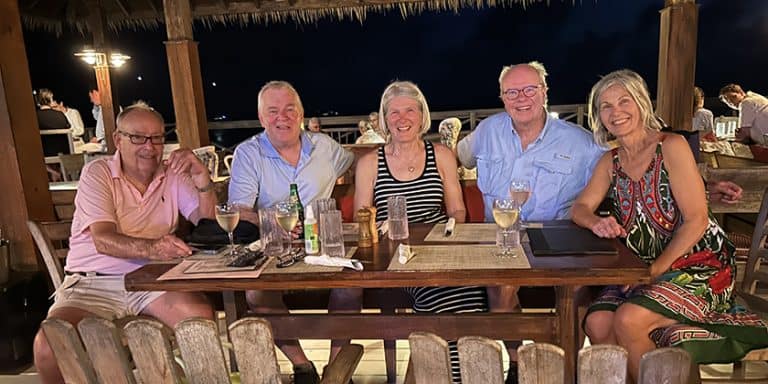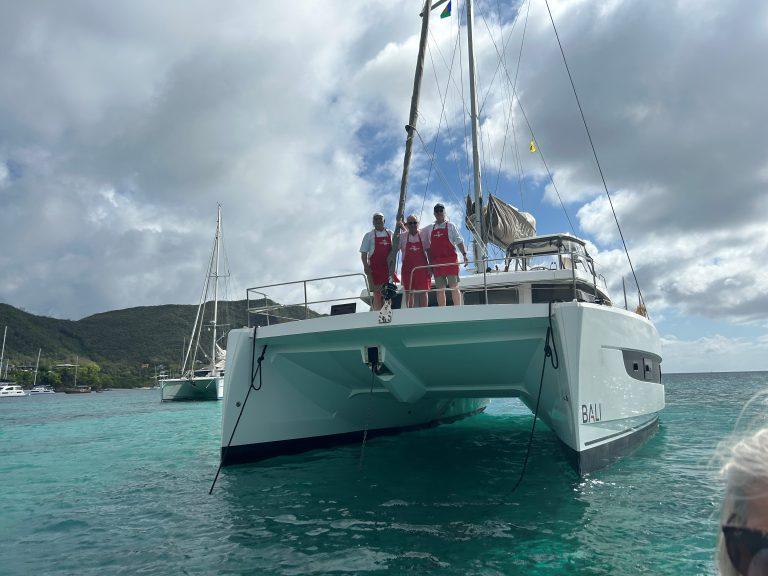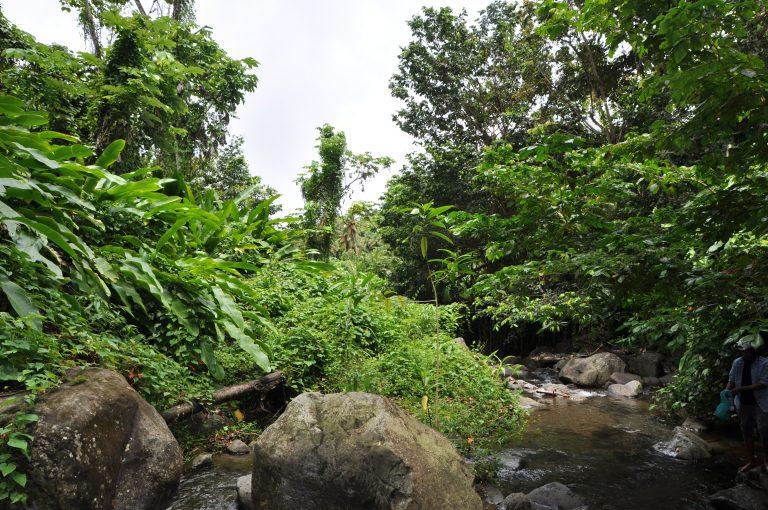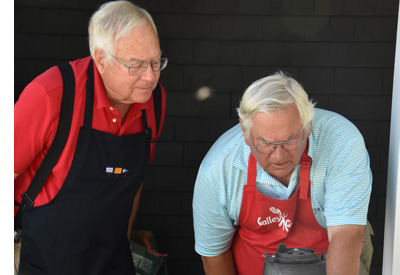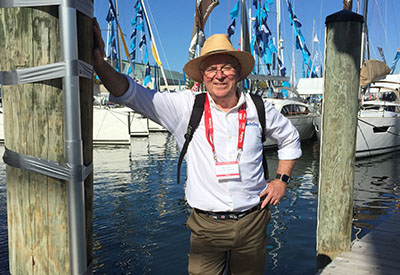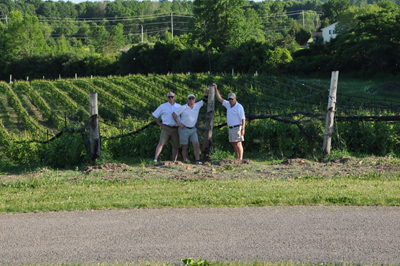Galley Guys Goes East
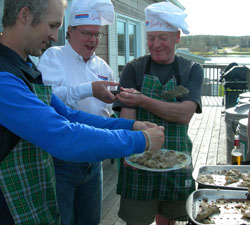
That famous east coast hospitality opened its arms to the Galley Guys last month during a trip to Nova Scotia.
We were visiting some of the Nova Scotia Boat Builders: Covey Island Boat Works in Lunenburg, North Atlantic Yachts in Halifax and Big Pond Boat Shop on Cape Breton Island on Bras d’Or Lake.
After spending the day onboard the latest 42-foot trawler from the Big Pond Boat Shop, boat builders Pat and Keith Nelder said, “We have a great surprise for you. We are going to have an impromptu Galley Guys dinner at the Wallace MacAskill Yacht Club in St. Peter’s.
Pat (who also manages the Atlantic Marine Trades Association) explained that it was one of her very favourite areas to go sailing and that St. Peter’s is really a very special place.
About St. Peter’s
St. Peter’s is one of North America’s oldest European settlements, tracing its history to the 1630s when a small, fortified settlement named “Saint Pierre” was built on the isthmus by merchants from La Rochelle, France. In 1650, La Rochelle merchant Nicolas Denys took possession of Saint Pierre and encouraged the fur trade with local members of the Mi’kmaq Nation; they used the isthmus as a canoe portage route between the Atlantic Ocean and Bras d’Or Lake. In addition to establishing a fur trading post, Denys later used the isthmus as a “haul over road” for portaging small sailing ships from Bras d’Or Lake to the Atlantic and vice versa.
Through the centuries, the area changed back and forth from French to British rule with the British eventually winning the area and naming all of what had been Acadia, Nova Scotia.
The village of St. Peter’s was founded early in the 1800s. Local residents rehabilitated Denys’ old “haul over road”, laying wood skids for portaging small sailing ships across the isthmus. The route through Bras d’Or Lake was considered a much shorter and safer voyage to Sydney than traveling around the exposed southern coast of Cape Breton Island.
In 1825 a feasibility study was undertaken and in 1854, construction of the St. Peter’s Canal began. The resulting channel was 2,600 ft long with an average width of 100 ft. The canal opened in 1869 and included a lock to regulate water levels which can vary 4.5 feet with tides.
The canal was designated a National Historic Site in 1929 and today, commercial shipping has largely avoided traveling through Bras d’Or Lake so the canal is almost exclusively used by pleasure boats, particularly sail boats cruising Bras d’Or Lake.
The ruins of Nicholas Denys’s Fort Saint Pierre are located on the grounds of the lock master’s house (ca. 1876) and the ruins of Fort Dorchester are located on Mount Granville which overlooks the Atlantic approach to the canal.
This is an area that appreciates history!
To share that history, Pat Nelder had informed some other members at the Wallace MacAskill Yacht Club that Canadian Yachting magazine would be visiting the area. Without hesitation, several yacht club members, including some of the club’s founders turned out to welcome the Galley Guys and to put on a wonderful and warmhearted evening of down east hospitality.
Grabbing the bull by the horns, Richard McIntosh, Chairman of the Village On The Canal Association, his wife Robin and son Rory went to work and organized a wonderful dinner for us.
Others who turned out included Doug Landry, the yacht club’s first commodore in 1998 and his wife Eva, also Ken LeVesconte who built his own 42 footer called Dunscrapen, Gerry MacDonnell, Clare Rankin and several other members – almost 2 dozen in all.
The weather was delightful and the facility looked great with new finger docks and a new concrete breakwall. The membership started with only 15 or 16 people in 1999 but has now risen to 42 members and shares the St. Peter’s Lion’s Club Marina facility.
Everyone knows each other and the group put on a memorable potluck dinner.
A special treat was that 14-year old Meagan Burke from French Cove came to the dinner. She has been playing the fiddle for eight years, and her wonderful music gave the evening an unmistakable air of east coast authenticity.
Richard and his wife started the evening off with an absolutely delicious recipe that they shared with us for Jerk Fish. Richard and Clare Rankin set up the barbecue and, in short order, had a delicious Jerk Fish appetizer for everyone.
As I was neither driving nor boating, I opened an Alexander Keith’s ale for that added flavor of the east coast while my hosts enjoyed Sleeman’s.
Inside the yacht club and marina kitchen, where Meagan Burke was playing the fiddle, Esther MacDonnell prepared an enormous pot of lobster chowder.
No recipe was offered, but the delicious chowder was chock-full of lobster and made a rich and filling main course for the evening. A selection of salads and dinner rolls rounded out the menu for the main course and then there was dessert!
From chunky nut-filled, homemade brownies to a remarkable cheesecake that was simply out of this world, the Galley Guys were treated to an entirely homemade potluck dinner and everything was amazing.
After dinner, Doug Landry and his wife Eva, took us down to the Wallace MacAskill Museum, located in MacAskill’s family’s original home. The charming building was full of MacAskill’s photographic work.
Of course, we can’t promise you a meal like this, but the hospitality is genuine and a visit to St. Peter’s is something that any sailor or yachtsman would enjoy. This glorious and historic area is unspoiled and not commercial at all. A night in a local hotel starts at $49.95!
The Galley Guys want to thank the gang at the Wallace MacAskill Yacht Club for a very special memory!
www.visitstpeters.com
About Wallace MacAskill
In Canada, Wallace MacAskill is best known for his photograph of the schooner Bluenose on the Canadian dime. That same photo has been on some 50¢ postage stamps as well.
The story has it that as a young boy, MacAskill stopped to assist a tourist passing through the area and as a reward for his kindness, the tourist gave MacAskill a little camera. Just a child at the time, this started MacAskill on a lifetime journey through photography. He wound up studying photography in New York City and published many books featuring his photographs of seascapes and sailing ships.
MacAskill was a real sailor as well and grew up to own a schooner called the Highlander, which was designed by Roue and built by McLennan’s in Lunenburg; the same builder who had made the Bluenose. Now designated a heritage property, the Wallace MacAskill Museum opened in 1986 and we are indebted to the Landry’s for guiding us through this charming facility.
Recipe
Jamaican Jerk Fish Recipe
Marinade
4 jalapeno peppers, seeded
4 green onions
1 shallot, peeled and cut in half
1/2 small onion, peeled
1 garlic clove, peeled
2 tsp. grated ginger
1/2 tsp. dried thyme
1 tsp. ground allspice
1 and 1/2 tbsp. vegetable oil
1 and 1/2 tbsp. soy sauce
1 and 1/2 tbsp. lime juice
1 and 1/2 tbsp. packed brown sugar
1 tbsp. salt
1 tsp. black pepper
1/2 cup water
Combine all ingredients in a food processor and grind until almost smooth. This recipe is enough for 2 lbs. of meat. Marinate fish or shrimp for 1 hour, chicken for 2 to 3 hours and pork for up to 6 hours.
By Andy Adams

